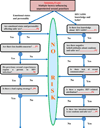A quantitative risk assessment of multiple factors influencing HIV/AIDS transmission through unprotected sex among HIV-seropositive men
- PMID: 21895567
- PMCID: PMC3248628
- DOI: 10.1080/09540121.2011.608418
A quantitative risk assessment of multiple factors influencing HIV/AIDS transmission through unprotected sex among HIV-seropositive men
Abstract
The objective of this study is to conduct a quantitative risk assessment of multiple factors influencing HIV/AIDS transmission through unprotected sexual practices among HIV-seropositive men. A knowledgebase was developed by reviewing different published sources. The data were collected from different sources including Centers for Disease Control and Prevention, selected journals, and reports. The risk pathway scenario tree was developed based on a comprehensive review of published literature. The variables are organized into nine major parameter categories. Monte Carlo simulations for the quantitative risk assessment of HIV/AIDS transmission was executed with the software @Risk 4.0 (Palisade Corporation). Results show that the value for the likelihood of unprotected sex due to having less knowledge about HIV/AIDS and negative attitude toward condom use and safer sex ranged from 1.24 × 10(-5) to 8.47 × 10(-4) with the mean and standard deviation of 1.83 × 10(-4) and 8.63 × 10(-5), respectively. The likelihood of unprotected sex due to having greater anger-hostility, anxiety, less satisfied with aspects of life, and greater depressive symptoms ranged from 2.76 × 10(-9) to 5.34 × 10(-7) with the mean and standard deviation of 5.23 × 10(-8) and 3.58 × 10(-8), respectively. The findings suggest that HIV/AIDS research and intervention programs must be focused on behavior, and the broader setting within which individual risky behaviors occur.
Figures
References
-
- Ajzen I. The theory of planned behavior. Organizational Behavior and Human Decision Processes. 1991;50:179–211.
-
- Ajzen I, Fishbein M. Understanding attitudes and predicting social behavior. Engelwood Cliffs, NJ: Prentice Hall; 1980.
-
- Angelino AF. Depression and adjustment disorder in patients with HIV disease. Topics in HIV Medicine. 2002;10(5):31–35. - PubMed
-
- Balzquez V, Madueno A, Jurado R, Fernandez-Arcas N, Munoz E. Human herpesvirus-6 and the course of human immunodeficiency virus infection. J Acquir Immune Defic Syndr Hum Retrovirol. 1995;9:389–394. - PubMed
-
- Benotsch E, Kalichman SC, Kelly JA. Sexual compulsivity and substance use in HIV-seropositive men who have sex with men: prevalence and predictors of high-risk behaviors. Addictive Behaviors. 1999;24(6):857–868. - PubMed
Publication types
MeSH terms
Grants and funding
LinkOut - more resources
Full Text Sources
Medical


